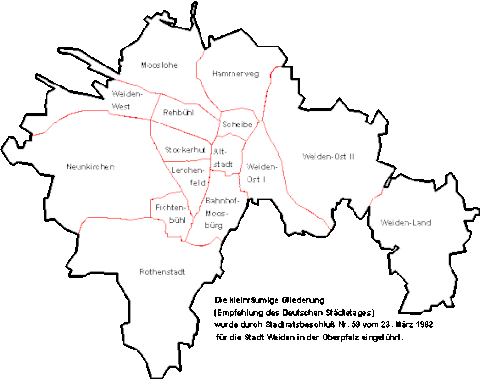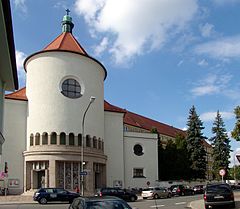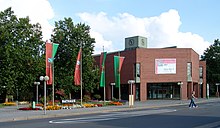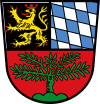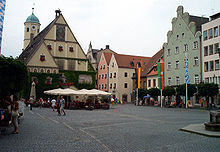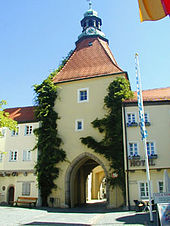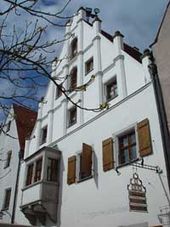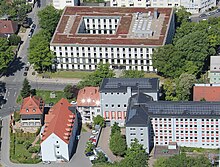Willows in the Upper Palatinate
| coat of arms | Germany map | |
|---|---|---|
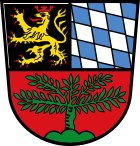
|
Coordinates: 49 ° 40 ' N , 12 ° 9' E |
|
| Basic data | ||
| State : | Bavaria | |
| Administrative region : | Upper Palatinate | |
| Height : | 397 m above sea level NHN | |
| Area : | 70.55 km 2 | |
| Residents: | 42,743 (Dec. 31, 2019) | |
| Population density : | 606 inhabitants per km 2 | |
| Postal code : | 92637 | |
| Area code : | 0961 | |
| License plate : | WHOM | |
| Community key : | 09 3 63 000 | |
| LOCODE : | DE WEI | |
| NUTS : | DE233 | |
| City structure: | 15 districts | |
City administration address : |
Dr.-Pfleger-Straße 15 92637 Weiden in the Upper Palatinate |
|
| Website : | ||
| Lord Mayor : | Jens Meyer ( SPD ) | |
| Location of the city of Weiden idOPf. in Bavaria | ||
Weiden in der Oberpfalz (officially Weiden idOPf. ) Is an independent city in the eastern Bavarian administrative district of Upper Palatinate . It is located 100 km east of Nuremberg and 35 km west of the border with the Czech Republic . Weiden is the regional center of the northern Upper Palatinate, a member of the Nuremberg Metropolitan Region and, after Regensburg, the largest city in the Upper Palatinate.
geography
Natural space and landscape
Weiden is located at the intersection of natural areas Oberpfälzer hills and Front Upper Palatinate Forest . In the urban area, these supraregional natural units are represented by the extensive wooded areas of Manteler Forst / Altenstädter Wald and Fischerberg, which are well developed by hiking trails . The landscape is characterized by the valley landscape of the Waldnaab , embedded between the undulating, pine-covered hills of the Upper Palatinate Bruchschollenland (the so-called overburden) in the west and the rugged variety of shapes of the ancient crystalline basement in the east. The floodplain area of the Waldnaab extends as a natural green corridor from north to south through the entire urban area. Overall, the urban area is located in the Northern Upper Palatinate Forest Nature Park and is the starting point for many hiking opportunities in a varied landscape. There are nine landscape protection areas and a geotope in Weiden (as of March 2017).
Neighboring communities
The urban district of Weiden is surrounded by the district of Neustadt an der Waldnaab with the district town of the same name in the north. The communities of Altenstadt an der Waldnaab , Störnstein , Schirmitz , Theisseil , Vohenstrauß, Pirk , Bechtsrieth , Luhe-Wildenau , Etzenricht , Weiherhammer , Mantel , Parkstein and Schwarzenbach (Upper Palatinate) are in the immediate vicinity of the city limits .
Land planning
The city is located in the Upper Palatinate North planning region (6).
Urban structure and land use
The city of Weiden in the Upper Palatinate is divided into 15 districts, each of which is further subdivided into three to eight, a total of 83, statistical districts.
|
* Main and secondary residence December 31, 2016
| Area and land use | |
|---|---|
| Area in ha | 7054 |
| Settlement in% | 20.8 |
| Traffic area in% | 8.8 |
| Agricultural area in% | 34.2 |
| Forest area in% | 31.3 |
| Water area in% | 1.1 |
| Area of other use in% | 3.8 |
The urban area of Weiden consists of the actual core city and several incorporations. The regional center consists of nine districts .
|
|
|
history
First mention so far
The name of the city is derived either from the occurrence of the willow tree (Old High German wida, Middle Low German wide) or from a "place to pasture, looking for fodder" (Old High German weida, Middle High German Weitha) and means "place near the willows or place to graze" .
In 1241 the place name “bei den Weiden” was mentioned for the first time as “apud Weithaa” in an inheritance dispute between King Conrad IV and the Vohburgers , Margraves of the Nordgau ; however, it is assumed that there was already a settlement around the year 1000. Located at the intersection of two important trade routes, the Goldenen Strasse in east-west direction and Magdeburger Strasse from south to north, Weiden in the Upper Palatinate soon developed as a trading and transshipment center. The city had been the seat of one of the seven courts of the Parkstein-Weiden Community Office since the 15th century , in which the Parksteiner Landrichter ruled together with twelve jury in cases of high and low jurisdiction . In 1531, Weiden in the Upper Palatinate already had 2,200 inhabitants. Two city fires, the Thirty Years War and the Plague brought setbacks for the city, from which it only recovered at the end of the 18th century. Between 1634 and 1635 and again from 1648 to 1650, Weiden was occupied by Swedish troops, most recently under the army leader Königsmarck . From 1714 the place belonged completely to the Duchy of Palatinate-Sulzbach , in 1777 the place came to Kurbayern . The real upswing of the city began in 1863 when Weiden was connected to the railway network. With the settlement of important glass and porcelain companies, the number of inhabitants grew, and by the turn of the century there were already almost 10,000 inhabitants.
On January 1, 1919, the city became a district by the decree of the first Republican Prime Minister Kurt Eisner (USPD) on December 17, 1918.
During the Second World War , the prisoner-of-war and penal camp Stalag XIIIB was located next to a Wehrmacht barracks in the west of the city . The French and Soviet prisoners of war and forced laborers who died between 1940 and 1945 were reburied in a grave complex in the city cemetery on Gabelsbergerstrasse.
At the end of the Second World War, on April 5, 1945, Weiden was again attacked by low-flying pilots. 15 planes bombed the area between the waterworks and the cemetery with 51 high explosive and over 1000 incendiary bombs. The war diary of the 8th Air Force shows that Weiden was attacked on that day by 30 "Flying Fortresses" B-17 with 94.3 tons of bombs. On April 16, 1945 at 8:30 a.m., American planes fired at the station, and a freight train carrying highly explosive explosives exploded. 60 people were killed in the explosion. On the night of April 22, 1945, the Wehrmacht withdrew from Weiden, and the war for the city was over.
Between 1945 and 1955, the population rose to over 40,000 as a result of the influx of refugees and displaced persons . Weiden has maintained this growth and expanded its economic power and infrastructure. The Weiden transmitter in the Upper Palatinate was shut down in 1956.
Since 1989, Weiden has benefited from German reunification and the opening of the border with the Czech Republic , which freed it from its peripheral location.
The pedestrian zone suffered heavy blows when first the Dänner department store and then the Hertie department store closed.
A good ten years passed through the planning, a jumped group of investors and finally completion until the new shopping center Nordoberpfalz-Center opened in 2019.
Incorporations
On January 1, 1914, the municipality of Moosbürg was incorporated with the municipal parts Moosbürg, Ermersricht, Fichtenbühl and Leihstadtmühle. On February 1, 1915, the districts of Tröglersricht and Zollhaus of the former community of Edeldorf followed.
The following incorporations took place on July 1, 1972:
- Community Frauenricht with the municipality parts Frauenricht, straws directional, Latsch and Spitalöd
- Muglhof municipality with the municipality parts Muglhof, Matzlesrieth (incorporated in 1938), Mitterhöll, Unterhöll, Oedenthal and Trauschendorf
- Municipality Neunkirchen b.Weiden with the municipality parts Neunkirchen, Brandweiher and Wiesdorf
On May 1, 1978 the community of Rothenstadt with the community parts Rothenstadt , Maierhof, Mallersricht (incorporated on July 1, 1972), Neubau, Ullersricht and the community part Moosöd of the community Altenstadt adWaldnaab were added. On November 1, 2006, 202 hectares of the community-free area "Manteler Forst" were incorporated due to the construction of a new logistics center.
population
|
|
Religions
Christianity
- Parish community parish Herz Jesu , parish St. Johannes
- Parish community parish St. Elisabeth, parish Maria Waldrast
- Parish of St. Konrad
- Parish of St. Dionysius
- Parish of St. Joseph
- Parish of St. Marien Rothenstadt
- Parish office Kreuz Christi
- Parish office Martin-Schalling-Haus
- Parish of Neunkirchen
- Parish of St. Mark
- Parish of St. Michael
- Parish of St. Bartholomäus Rothenstadt
- Pastor Weiden-Ost
- Evangelical Free Churches
- Adventist Church
- Free Gospel Church
- Free Christian Church
- Community way of life
- Other free churches that do not belong to the “Working Group of Christian Churches”
- New Apostolic Church (Weiden)
- Jehovah's Witnesses pastures
Church youth work takes place in the Evangelical Youth Weiden, the Catholic Youth Office Weiden and in the New Apostolic Church Weiden.
Judaism
There is a Jewish community in Weiden . Your synagogue is on Ringstrasse. The old Jewish cemetery is on the Weiden – Oberkotzau railway line in Sperlingstrasse. Since it is fully occupied, a new Jewish cemetery was created on the site of the Weiden forest cemetery. In the Konrad-Adenauer-Anlage next to the Josefskirche there has been a memorial stone since 1989 for the 34 Weidener Jews who were murdered in concentration camps during the reign of National Socialism . The memorial stone was created by Max Fischer from Neustadt an der Waldnaab.
Islam
- Arab-German mosque - German-speaking Muslim group in Weiden eV
- Weiden Islamic Center
- Selimiye Camii - Education and Culture Weiden e. V.
- Yeni Cami
politics
City council
The city council in Weiden consists of 40 councilors, who have the title of "city councilor". They are re-elected every six years. The latest election took place on March 15, 2020. This led to the results shown in the diagrams.
Lord Mayor
On September 1, 2007, Kurt Seggewiß ( SPD ) took over the office of Lord Mayor from Hans Schröpf ( CSU ). After two convictions for breach of trust and tax evasion to the benefit of the city administration, Hans Schröpf resigned from his office for health reasons, so that there was an early election of mayor. Here Kurt Seggewiss prevailed in the runoff election against the incumbent mayor Lothar Höher (CSU) with 58.37% of the vote. As early as 2017 Seggewiß declared that he did not want to run again. In the local elections in 2020 , Jens Meyer, another SPD candidate, won the office. Meyer prevailed in the runoff election with 51.3% of the vote against Benjamin Zeitler (CSU).
Important Lord Mayors before 1933
- Melchior Probst (1884–1934), from 1919 second legally qualified mayor, from 1929 to 1933 first legally qualified mayor, who gave his name to Bürgermeister-Probst-Straße.
Lord Mayor since 1933
- 1933–1945: Hans Harbauer , NSDAP (elected by the city council)
- 1945: Josef Schnurrer , independent (provisional)
- 1945–1948: Franz Joseph Pfleger , CSU (provisional, elected by the city council from 1946)
- 1948–1951: Karl Heilmann , CSU (elected by the city council)
- 1951–1952: Philipp Karl , CSU (elected by the city council)
- 1952–1970: Hans Schelter , SPD (first direct election)
- 1970–1976: Hans Bauer , SPD
- 1976–2007: Hans Schröpf , CSU
- 2007–2020: Kurt Seggewiß , SPD
- since 2020: Jens Meyer , SPD
coat of arms
| Blazon : “Divided and split above; in front in black a red crowned, red armored golden lion, behind the Bavarian diamonds; below in red on a green three-mountain a green pasture. " | |
| Justification of the coat of arms: The Palatinate lion and the Bavarian diamonds are reminiscent of the earlier rule of the Wittelsbachers . The willow tree on a green Dreiberg is the eponymous symbol of the city's coat of arms. |
City partnerships and sponsorships
- Town twinning

-
 Issy-les-Moulineaux , France, since 1962 (first meetings 1954)
Issy-les-Moulineaux , France, since 1962 (first meetings 1954) -
 Macerata , Italy, since 1963 (first encounters 1954)
Macerata , Italy, since 1963 (first encounters 1954) -
 Weiden am See , Austria, since 1969
Weiden am See , Austria, since 1969 -
 Annaberg-Buchholz , Germany, since 1990
Annaberg-Buchholz , Germany, since 1990 -
 Mariánské Lázně ( Marienbad ), Czech Republic, since 2008
Mariánské Lázně ( Marienbad ), Czech Republic, since 2008
- partnership
-
 US Army Garrison , Grafenwoehr , since May 2008
US Army Garrison , Grafenwoehr , since May 2008
- Sponsorships
- About the expelled Sudeten Germans of the home district of Tachau since 1956
- from 1971 to 1991 she was a fast minesweeper, the Scorpion
- Mine-hunting boat Weiden decommissioned in June 2006
- Lufthansa - Boeing 737-300 Weiden in the Upper Palatinate since 1992
- Artillery battalion 131 , Ostmark barracks in Weiden
- DB railcar 610 018/518 "Stadt Weiden" (1996-2013)
- German Alpine Club Section Weiden with Weidener Hut , Tyrol since November 16, 2009
Culture and sights
theatre
After the Second World War, cities like Weiden, which did not have their own theater, were provided with stage performances by the city and state theaters. Weiden was played by the municipal theater in Hof from the 1950s. In the 1960s, the increasingly important touring theaters overtook these theater companies.
In Weiden the book and art dealer Hubert Schlegl organized the first touring theater performances between 1968 and 1970. What was new was that constantly changing ensembles with two to four stars at the top came to the city. In 1970/71 an entire season with five theater performances was offered for the first time under the name of the organizers, Kleine Bühne . Until 1991, the Josefshaus and its stage, which was continuously improved with funds from the Small Stage , served as a venue. Since then, the stage system of the Max-Reger-Halle has been available to the small stage for their events.
With the 2010/2011 season, the Upper Palatinate State Theater can be seen with guest performances and in-house productions in the Max-Reger-Halle and on the chamber stage of the regional library.
Museums
- International Ceramic Museum Weiden , branch museum of the New Collection
- City museum in the Hans Bauer cultural center
- The traditional name of the old school building comes from the fact that both the German school and the Latin school had been located there since the 16th century. Today, in addition to the city museum and the Max Reger collection, the gallery in the old school building with changing exhibitions of local artists is housed in the building. The city archive is also located in this building.
- Tachauer Heimatmuseum in Weiden in the cultural center
- Railway museum of the Modellisenbahnclub Weiden e. V.
- Hammer- Herzer Gallery
- Max Bresele Museum
Library
- Regional library in the Waldsassener Kasten
- The administration building with granary of the Cistercian order of the Waldsassen monastery from the 18th century now houses the library in a 2260 m² light-flooded reading room. The neighboring 400-year-old hall tower, part of the former city fortifications, is used as a further administrative building.
- Around 300,000 people live in the catchment area of the cross-border regional library, including numerous readers from the Czech Republic. The media inventory includes over 120,000 books, cassettes, CDs, videos, DVDs, CD-ROMs, newspapers and magazines.
music
Events, master classes and competition: sponsorship award from the Weiden Max Reger Days
- Association for Chamber Music - Weidener Master Concerts
The association has organized five to six concerts with internationally renowned musicians since 1961, and has been in the Max-Reger-Halle since 1992.
- Weidener Musiktage
The Weidener Musiktage took place every three years. On these days, Max Reger's music was related to the music of his time or other epochs under a certain aspect.
- Weiden Jazz Circle , founded in 1975.
Buildings
Marketplace
- The market square extends between the Upper and Lower Gate. In between is the old town hall. The Obere Markt with its gabled houses from the period after 1540 extends between the Upper Gate and the Old Town Hall. Between the old town hall and the lower gate is the lower market , which is the location of the four large annual markets, which have been passed down since 1396, and the weekly market that takes place on Wednesdays and Saturdays. Many town houses have Renaissance style features.
Old Town Hall
- The old town hall was built by the master builder Hans Nopl, the master carpenter Hans Stieber and the stonemason Andreas Falk from 1539 to 1545. It was rebuilt from 1914 to 1917. The carillon was donated to the city in 1983. As in earlier times, shops have been set up on the ground floor of the town hall since 1981. The beamed ceiling in the large boardroom is a fine work of the 16th century. The old town hall used to be not only an administration building, but also the center of social life in the city. Many theater and dance events took place there. Today a city council meeting is held there once a year. Weddings and special receptions also take place in this historic building.
Upper gate
- You enter the old town through the newly designed anchor complex and the Upper Gate. Until 1840 this gate had a semicircular front wall, the Rondell, with two round towers. To expand the street, the gate with double hipped roof was demolished in 1911 and rebuilt in a simplified form. To the left of the gate begins the mighty building of the Vesten House, the official seat of the rulership of the Parkstein-Weiden community office. Count Palatine Friedrich von Parkstein lived in the fortress house from 1585 to 1593 as a residence; his two sisters-in-law, the princesses of Liegnitz, are buried in the Evangelical Lutheran parish church of St. Michael.
St. Michael
- The Protestant parish church of St. Michael is originally a Gothic, Baroque-style hall church, which has become known in particular as the place where Max Reger worked .
Old school house
- The Hans Bauer cultural center in the old school house houses the town museum, the town archive, the Max Reger rooms, the town gallery and the Tachau local history museum with memorabilia from the sponsors' circle and the town of Tachau in Bohemia. The building was built in 1529 as a grain box by the Weiden cloth makers. The city fire in 1536 destroyed the house to the ground. After the new building in 1565, the Latin School and the German School were housed there. This is where the traditional name of the old school comes from . The building was completely restored from 1975 to 1979.
Lower gate
- The lower gate and the front gate - created in its present form after the bombardment in 1635 - lead to Schlörplatz. The pedestrian passage was created in 1955 after the gate was damaged by American tanks. The Lower Gate is currently the seat of the local Marian Congregation (MC) youth association , a subsidiary of the J-GCL .
old citywall
- When looking over the Stadtbach from Kurt-Schumacher-Allee and from the New Town Hall, you can see the southwest corner of the old city fortifications with the main wall, the Zwingermauer, the corner bastion and the shell tower. It cannot be determined when willow was first fortified. A document from the year 1347 handed down the instruction of the later Emperor Charles IV that the burgraves of Nuremberg should improve, build and fortify the fortress Floß and Parkstein as well as the market Weiden. At this point in time at the latest, Weiden received its first wall, but it is possible that an existing city wall was raised and reinforced by adding towers.
St. Sebastian
- The Neustift chapel was built in Sebastianstraße in 1486. Destroyed by lightning and war, the church was rebuilt in 1692 and consecrated to St. Sebastian again in 1697. The Renaissance tombstone of the twin children of Count Palatine Friedrich von Parkstein, who died in Weiden in 1590, is attached to the western choir arch. Next to the ornate iron grating under the gallery is a copy of the image of the Virgin Mary donated in 1792 to the chapel of the Holy Staude in the original frame.
Max Reger House
- The last residence of the Reger family in Weiden before they moved to Munich in 1901 is on Bürgermeister-Prechtl-Straße. The composer Max Reger (1873–1916) spent his youth in Weiden, where he created his most famous organ works. Among many other things in town, a plaque on the house commemorates him.
Gustav von Schlör memorial
- The Gustav-von-Schlör monument stands between the anniversary oak from 1824, which was planted for the 25th anniversary of King Max I's reign, and the peace oak from 1871. It commemorates the last Bavarian trade minister, Gustav von Schlör (1820– 1883), which reached Weiden's railway connection in 1863 and thus established the city's economic boom. The monument was designed by the architect Carl Hocheder , Munich, the marble bust by the sculptor Theodor Haf .
Waldsassener box
- The Waldsassener Kasten, built between 1739 and 1742 by the Baroque master builder Frater Philipp Muttone, has housed the International Ceramic Museum since 1990 . There is a permanent exhibition of the Bavarian State Museums and exhibits from the local porcelain industry. The regional library is also housed in this building.
St. Joseph
- The Catholic parish church of St. Josef was built in 1900/1901 in just 18 months and is the largest church building in the Regensburg diocese since the Middle Ages.
→ Main article: St. Josef (Weiden in the Upper Palatinate)
Hall tower
- The hall tower is the last remnant of the old suburban wall, which, as the outer city wall, enclosed the city extensions in the wall ring in 1575. This city wall once had four gate towers and two round towers (Rossturm and Flurerturm). The master builder of the suburban wall was Master Reicholt. When the city was besieged in 1634 and a clear field of fire was needed, the suburban wall was torn down. The hall tower was the only part that was rebuilt in 1694 and has been called that since then because it was the official residence of the town hall. Before it was called Karlsturm. Today the corridor tower houses the prevention facilities of the Weiden police.
Max Reger Park
- The Nepomuk Chapel is located at the entrance to the Max Reger Park. The bridge chapel St. Johannes Nepomuk was built in 1738/1756 on the basis of a pledge by Field Marshal Fellner von Feldeck. The sandstone statue of St. Johann Nepomuk was created by the sculptor Johann Franz Dult from Nabburg. In the Max-Reger-Park stands the Max-Reger-Monument created in 1957 by the Weiden sculptor Josef Gollwitzer, a mighty granite block, modeled after organ pipes; the composer lived with his parents in Weiden from 1874 to 1901. There is also the Triton fountain, created in 1953 by the same artist. In the summer months, the Weiden Summer Serenades take place in the Max-Reger-Park .
Max Reger Hall
- As a homage to the composer and organist Max Reger , the Max-Reger-Halle Culture and Congress Center was built between 1989 and 1991 . The Gustl-Lang-Saal (capacity up to 900 people) was named after the former Bavarian Minister of Economic Affairs August Lang , the Gustav-von-Schlör -Saal (up to 360 people) bears the name of the last Bavarian Minister of Commerce, the Weiden the railway network owes. This hall is the cultural center of the city. In addition, several conference rooms and the foyer can be used.
Other buildings
- A memorial plaque on the house at Frauenrichterstraße 50
- recalls the Weiden Eduard Krohner , in 1942 in the Dachau concentration camp of tyranny NS fell victim.
- The Jewish cemetery on Fohlenweg northeast of the old town has been occupied since 1901. There are about 80 tombstones on it .
Events
- Weidener Bürgerfest (since 1973) (last weekend in June)
- Weiden Children's Citizens' Festival (since 1993) (always on the 3rd Sunday in July from 11 a.m. to 6 p.m.)
- Weiden Literature Days
- Weiden Max Reger Days
- Weidener jazz seminar
- Weidener Night Run
- Weidener Spring Festival (since 1935) (around May 1st)
- Weidener Volksfest (since 1897) (around August 15)
- Weiden art enjoyment until midnight
- Willow dreams
- Weiden Advent market
- Weidener KinderKunstAkademie as part of the municipal holiday program
- INJOY Triathlon Weiden in the Schätzlerbad of SV Weiden
- Bavarian-Bohemian Culture and Business Days
Economy and Infrastructure
In 2016, Weiden in the Upper Palatinate, within the city limits, achieved a gross domestic product (GDP) of € 2.272 billion. In the same year, GDP per capita was € 53,734 (Bavaria: € 44,215 / Germany € 38,180) and thus well above the regional and national average. In 2017 there were around 41,800 gainfully employed people in the city. The unemployment rate in December 2018 was 5.3% and thus well above the Bavarian average of 2.7%.
In the Future Atlas 2016 , the urban district of Weiden in the Upper Palatinate ranked 182nd out of 402 rural districts, municipal associations and urban districts in Germany, making it one of the regions with a "balanced risk-opportunity mix" for the future.
Economic structure
Today around 42,000 people live in the Oberzentrum Weiden in the Upper Palatinate on an area of 70.5 km². Weiden in the Upper Palatinate was never a typical industrial city: In 2015, of the 26,567 employees subject to social insurance contributions, only one in five worked in the manufacturing sector , while over three quarters were registered in the service sector . Industry and commerce have changed dramatically in the last two decades. The monostructure of glass and porcelain was dismantled and supplemented by companies in vehicle construction, plastics processing and processing and microelectronics. Companies such as Bauscher , Seltmann and Nachtmann are still a focus in the manufacturing sector today.
Within the Upper Palatinate North region , the city of Weiden has a prominent position in economic terms. The gross domestic product per inhabitant at the turn of the millennium was 39,896 euros, in 2013 50,467 euros (source: Genesis database of the State Office for Statistics in Bavaria ). This corresponds to an increase of over 26.5%. Leisure and recreational opportunities, all types of schools and good shopping opportunities also affect the catchment area of more than 300,000 people. Along with Amberg, Weiden is one of the cultural and economic centers of the northern Upper Palatinate.
According to the state development program Bavaria Oberzentrum, Weiden is the trade and service center of the Upper Palatinate North region. The mail order company Witt Weiden , the hotel porcelain company Bauscher Weiden and the porcelain manufacturer Seltmann Weiden are well known . Weiden is also the headquarters of the Auto -teile-Unger company and two large supraregional bakeries. The German Post AG has in Weiden, the headquarters of the Post Philately for sending collectors stamps. The current director is Alexander Plum.
Smaller employers are also Heidelberg Web Carton Converting GmbH, a subsidiary of Heidelberger Druckmaschinen AG with around 100 employees, and Oberpfälzische Waggon Service GmbH . The latter settled in 2010 on the site of an old repair shop , which was used from 1988 to 2007 by the company PFA (partner for vehicle equipment) and Stadler Rail .
BM Industrieboden GmbH, which operates across Germany, is also in Weiden idObpf. resident.
A structural change is reflected in the massive job cuts in the local lead crystal and porcelain industry , so that Weiden suffers from persistently high unemployment.
The NOC Weiden is important for Weiden as a shopping city . The shopping center, opened in 2019, offers 18,000 m² of space for around 55 shops.
media
The local television station O-TV ( Oberpfalz TV ) based in Amberg can now receive Vodafone in the cable network of Vodafone Kabel Deutschland . Also on the satellite position ASTRA 19.2 East, this station was initially broadcast under the broadcast name TVA-OTV, alternating with program content from the Regensburg broadcaster TVA . A separate transponder has been used since April 1, 2018 and the program is broadcast 24 hours a day in HD quality.
In the old town on Unteren Markt is the local radio station Radio Ramasuri , which broadcasts its program on VHF 99.9 MHz and on other frequencies for the entire northern Upper Palatinate. Radio Galaxy (FM 89.8 MHz) broadcasts especially for young audiences . Since July 3, 2018, both channels have also been broadcast via DAB + (Upper Palatinate broadcasting area - Block 12D).
The regional newspaper Der neue Tag is the largest newspaper in the North Upper Palatinate and the only daily newspaper in the region with a circulation of around 70,000 copies a day (except Sundays) . It reaches 260,000 readers.
Two advertising newspapers, Rundschau and OWZ ( Oberpfälzer WochenZeitung ) share the advertising market. Expuls appears as a culture magazine .
Public authorities and institutions
- Federal agency for work
- Office for Digitization, Broadband and Surveying
- Office for Food, Agriculture and Forestry
- Weiden District Court
- Labor Court Weiden
- Federal Finance Directorate Southeast - Weiden location
- Bundeskasse Halle / Saale - Office Weiden / Upper Palatinate
- Federal Police Station Weiden
- armed forces
- Deutsche Rentenversicherung Bayern Süd, information - advice - auditing service
- Weiden tax office
- Weiden volunteer fire brigade , 2 fire stations, five local fire departments in the districts of Frauenricht, Mallersricht, Muglhof, Neunkirchen and Rothenstadt
- Criminal Police Inspection Weiden
- State Office for Finance - Regensburg Office - Weiden processing office
- Weiden district court
- Correctional facility
- Neustadt District Office, Health Service Department in Weiden
- Police Inspection Weiden
- Weiden public prosecutor's office
- State building authority Amberg-Sulzbach road maintenance service building Weiden
- Traffic Police Inspection Weiden
- Water Management Office Weiden
- Main customs office in Regensburg, branch in Weiden
- Career advice office of the Bundeswehr
-
Ostmark barracks
- 3./Raketenartilleriebataillon 132, from 2014 the new artillery battalion 131 (from parts of the observation tank artillery battalion 131 from Mühlhausen in Thuringia)
- Training Support Company 122 (former 5th / Panzer Grenadier Battalion 122 in Oberviechtach )
- Federal Language Office , Section S 9
- Integrated control center (ILS) North Upper Palatinate
- Kliniken Nordoberpfalz AG , Klinikum Weiden
Educational institutions
Elementary schools
- Albert Schweitzer School
- Clausnitz School
- Gerhardinger School
- Hammerweg School
- Hans Sauer School
- Hans Schelter School
- Montessori school
- Rehbühlschule
Special educational support center
- Stötznerschule
- The special needs school educates, teaches, advises and supports children and young people who are disabled or threatened by disability, sick or temporarily impaired in their performance and therefore require special educational support.
- For the entrance area (1st and 2nd grade) special educational diagnosis and support classes have been set up, which convey the content of the general elementary school in small classes with specially trained staff. As a rule, the children have three years to complete the content that is taught in the general primary school within two years. From the third year of pupils onwards, the school teaches in small classes according to its own curriculum with the mandate of individual learning support. For the preventive area, the school preparatory facility (SVE) is located in Asylstrasse. This support can begin three years before compulsory schooling.
Middle schools
- Max Reger Middle School Weiden
- Pestalozzi Middle School
Realschulen
- Hans-Scholl-Realschule, state school for boys
- Sophie-Scholl-Realschule, state secondary school for girls
Business school
- Gustl Lang School Weiden
High schools
- Augustinus grammar school , linguistic grammar school (English, French, Latin, Spanish, ancient Greek), including the humanistic branch and economic and social science grammar school with business informatics.
- Elly-Heuss-Gymnasium , Linguistic Gymnasium and Economics and Social Science Gymnasium (Social Science Orientation [WSG-S]) for girls (languages: English, French, Latin, Spanish).
- Kepler grammar school , science and technology grammar school and linguistic grammar school (English, French, Latin, Spanish, Italian).
professional school
- European vocational school - State vocational school Weiden
- Different subjects are trained, there are the commercial departments of construction, wood, paint technology, electrical engineering, automation and mechatronics, metal technology, food, personal care and the commercial departments (consulting professions: bank clerks and tax clerks, commercial and industrial professions, office professions, health professions) .
- The European vocational school is currently attended by around 3500 students, taught by around 150 teachers (around 80 of them full-time).
- The vocational school was a participant in the model experiment Modus 21 and as a vocational school has also been represented in the model experiment Profil 21 since 2006 .
- At the school there are study seminars for the fields of metal technology , social studies and economics .
Vocational schools and technical schools
- The Foreign Language Vocational School enables qualified training in two years. This includes the foreign languages English, French, Spanish or Italian, the elective subject Czech as well as general education and economics subjects.
- Vocational school for nursing at the Weiden Clinic in Upper Palatinate
- Vocational school for children's nursing at the Weiden Clinic in Upper Palatinate
- BRK technical school for elderly care
- Agricultural school
- Church professional academy for social education
- State Higher Agricultural School Almesbach for agricultural professions
Technical college, vocational college
- The Gustav-von-Schlör-Schule is a state technical college (FOS) and offers training in technology, economics, social affairs and design. Classes and practical training take place in the 11th grade. The 12th grade has full-time instruction and ends with the Fachhochschulreife examination.
- The Gustav-von-Schlör-Schule is also a vocational high school (BOS) with the fields of technology and economics. The assignment depends on the profession you have learned. Pupils who have obtained the secondary school leaving certificate through vocational school, a vocational school or the Quabi are advised to attend the preliminary class. In full-time lessons they are brought up to the level of knowledge required for the 12th grade. The secondary school leaving certificate can also be made up for by successfully attending the preliminary stage. If you skip the preliminary class, you will go straight to the 12th class of the BOS - provided you have an intermediate educational qualification. At the end there is the technical college entrance exam.
- The 13th grade BOS was offered for the first time in Weiden in the 2005/06 school year, with the subjects economics and technology. In the 13th grade, the subject-specific, and with a second foreign language the general higher education entrance qualification can be acquired.
- The common entry requirement for the FOS and BOS is an intermediate educational qualification and proof of suitability.
East Bavarian Technical University (OTH) Amberg - Weiden
The Weiden department of the Amberg - Weiden University of Applied Sciences comprises the following areas:
- Business Administration (Bachelor)
- Trade and Service Management (Bachelor)
- Languages, Management and Technology (Bachelor)
- Medical technology (Bachelor)
- Industrial Engineering (Bachelor)
- Human Resource Management (Master)
- Intercultural Business and Technology Management (Master)
- Marketing Management (Master)
- Economics and Law (Master)
Other schools
- Franz Grothe School - Städt. music school
- Community College
- Army NCO School (USH)
- The Bundeswehr is in the Ostmark Barracks (Teaching Group D, servicing agent ZAW) in civil Vocational Education and Training (ZAW) soldiers from u. a. as IT system electronics technician , IT specialist and professional driver .
Transport links
Road traffic
Trunk roads
-
Federal motorways :
-
 : ( Dresden - Chemnitz ) - Autobahn triangle Hochfranken - Hof - Weiden - Schwandorf - Regensburg - Wolnzach / Autobahn triangle Holledau ; over to Munich .
: ( Dresden - Chemnitz ) - Autobahn triangle Hochfranken - Hof - Weiden - Schwandorf - Regensburg - Wolnzach / Autobahn triangle Holledau ; over to Munich .


-
-
Federal highways :
-
 : Würzburg - Bayreuth - Weiden - Cham
: Würzburg - Bayreuth - Weiden - Cham
-
 : Bad Windsheim - Forchheim - Auerbach in the Upper Palatinate - Weiden
: Bad Windsheim - Forchheim - Auerbach in the Upper Palatinate - Weiden
-
Before the construction of the autobahn and the graduation to the state or district road in the section between Altenstadt and Schwandorf , the federal road 15 ( Hof - Schwandorf - Regensburg - Rosenheim ) was the main connection to Regensburg, which ran north-south through Weiden (today : St 2657).
Tourist routes
Four tourist roads run through the city:
- The Golden Street was a trade route between Nuremberg and Prague . It brought prosperity to the villages and towns on the road. The opening of the border in Bärnau means that at least hikers and cyclists can follow the course of the medieval road.
- The Bavarian Porcelain Route leads from Bamberg via Coburg , Hof , Selb and Weiden to Bayreuth. It symbolizes the great tradition of "white gold" in the region. The Bauscher (catering porcelain) and Seltmann (household porcelain) factories are still producing in the city today.
- The 300 km long glass road leads from Waldsassen via Weiden along the federal road 22 to Passau and connects the places in the Upper Palatinate and Bavarian Forests, some of which still produce glass today . From 1891, flat glass was produced in the city. Today's float glass plant is located in the neighboring community of Weiherhammer . Today, lead crystal glasses are manufactured in the Nachtmann branch in Weiden.
- The European Goethe Street leads from Karlsbad in the Czech Republic via Weiden, Regensburg and Innsbruck to Venice .
Rail transport

The Weiden (Oberpf) train station is on the Weiden – Oberkotzau (–Hof) , Regensburg – Schwandorf – Weiden , Weiden – Bayreuth and (Nürnberg–) Neukirchen (near Sulzbach-Rosenberg) –Weiden lines , which are part of the Nuremberg - Neustadt (Waldnaab) is connected. It is located south in the urban area of Weiden.
Local public transport
The urban area is served by seven bus routes (lines 1–7) in normal traffic and by six bus routes (lines 91–95, 98) in light traffic, all of which meet at the central bus station opposite the New Town Hall. Normal traffic, with buses running every 15 or 30 minutes, applies from Monday to Friday from around 6:00 a.m. to around 6:15 p.m. Before 6:00 a.m. and from 6:15 p.m. as well as on Saturdays, Sundays and public holidays, the low-voltage traffic network applies at 40-minute intervals.
Upper Palatinate North Tariff Association (TON)
The local transport association Weiden-Neustadt (NWN) has also joined the tariff association TON - Tarif Oberpfalz Nord . Thus, there is a uniform tariff area that includes the northern and central Upper Palatinate, but without local rail transport integration .
EgroNet cooperation network
The city of Weiden idOPf. is a member of the EgroNet transport association . The tariff area extends to parts of Bavaria , Thuringia , Saxony and the Czech Republic .
Regensburg Transport Association (RVV)
From April 1, 2016, travelers can also use the RVV tariffs on the Regensburg – Weiden railway line .
air traffic
The Weiden-Latsch airfield has a 600 × 60 m runway, of which 580 × 10.5 m are concrete runways.
The rescue helicopter Christoph 80 of the type EC 135 , which is operated by the DRF Luftrettung , has been stationed there since April 2011 .
Long-distance cycle paths
Weiden is located on the Waldnaabtal / Naabtal cycle path from Bärnau to Regensburg. The Bockl cycle path branches off from it in Neustadt, approx. 5 km to the north , with a length of over 50 km it is the longest railway cycle path in Bavaria. This takes you via Floß , Vohenstrauß , Pleystein and the border crossing at Tillyschanz near Eslarn to Pilsen in the Czech Republic . In addition, the Pan-European cycle path leads through pastures .
Long-distance hiking trail
The 660 km long Goldsteig leads through the Upper Palatinate Forest near the city.
Access to the Goldsteig:
- No. 6A: Weiden - Wilchenreuth (North), length: 6.4 km
- No. 6B: Weiden - Muglhof (south), length 7.2 km
Personalities
sons and daughters of the town
- Erhard Weigel (1625–1699), philosopher and mathematician
- Franz Ferdinand von Rummel (1644–1716), Prince-Bishop of the Diocese of Vienna (1706–1716)
- Simon Feilner (1726–1798), plasterer, porcelain painter and modeller
- Eduard Zachäus Herrmann (1807-1854), Bavarian MP and town clerk
- Josef von Herrmann (1836–1914), civil servant and politician
- Alois Ritter von Frank (1859–1940), State Secretary in the Reich Ministry of Transport, President of the Reich Railway Directorate in Munich
- Eduard Götz (1876–1961), master painter, decorative and artist painter
- Michael Lukas (1877–1955), politician
- Hans Strobel (1881–1953), German architect and urban planner
- Wilhelm Vierling (1885–1974), sculptor and painter
- Eduard Zintl (1898–1941), chemist and university professor
- Otto Ambros (1901–1990), chemist and convicted war criminal
- Martin Gottfried Weiß (1905–1946), SS-Obersturmbannführer , camp engineer, concentration camp commandant and convicted war criminal
- Paul Stöcklein (1909–1999), Germanist, literary scholar and university professor
- Rudolf Glötzner (1917–2010), athlete and gynecologist
- Elisabeth Schärtel (1919–2012), opera singer
- Adolf Wolfgang Schuster (1919–2004), lawyer and local researcher
- Franz Josef Zebisch (1920–1988), SPD city councilor since 1956, MP from 1965–1980, honorary citizen of the city since 1984
- Hermann Bogner (1921–2012), agricultural scientist and university professor
- Hermann Schätzler (1923–2009), painter and draftsman
- Günther L. Eckert (1927–2001), architect
- Erich Bäumler (1930–2003), former national soccer player
- Ekkehardt Hofmann (* 1942), painter, author and lecturer
- Marga Schiml (* 1945), opera singer
- Ulrike Müller-Böker (* 1953), geographer and university professor
- Horst Eckert (* 1959), author of detective novels
- Michael Brenner (* 1964), historian
- Thorsten Otto (* 1964), radio host on Bayern 3
- Matthias Matuschik (* 1965), radio presenter on Bayern 3
- Monika Henzinger (* 1966), computer scientist
- Michael Ammann (* 1967), composer and performer
- Gerwin Eisenhauer (* 1967), jazz drummer
- Michael Dornheim (* 1968) national volleyball player
- Christian Schwägerl (* 1968), science journalist and author
- Marco J. Riedl (* 1969), film director, screenwriter and cameraman
- Christian Freuding (* 1971), German officer
- Lars David Kellner (* 1973), pianist and doctor
- Franz Vitzthum (* 1973), German countertenor
- Uli Grötsch (* 1975), politician (SPD)
- Kathrin Anna Stahl (* 1977), actress, singer and filmmaker
- Alexandra Liedl (* 1979), psychologist, psychotherapist and non-fiction author
- Daniel Grünauer (* 1982), dramaturge, director and author
- Stephan Oetzinger (* 1984), politician (CSU)
- Benedikt Schopper (* 1985), ice hockey player
- Nadine Kraus (* 1988), soccer player
- Sven Kopp (* 1995), soccer player
- Dennis Lippert (* 1996), soccer player
- Kay Bruhnke (* 2001), basketball player
Other personalities associated with the city
- Gustav von Schlör (1820-1883) brought the railway to Weiden and in 1878 was made an honorary citizen of Weiden
- Kurt Eisner (1867–1919), first republican Bavarian Prime Minister (USPD), who ruled Weidens' (still existing) "Kreisfreit" on January 1st, 1919.
- Max Reger (1873–1916), composer and organist, grew up in Weiden
- Johannes Stark (also Johann Stark; 1874–1957), physicist, winner of the Nobel Prize in Physics for the discovery of the Stark effect , lived in Ullersricht
- Franz Mörtl (1878–1935), social democratic city councilor, concentration camp prisoner in Dachau
- Otto Seeling (1881–1955), entrepreneur, industrialist, founder; Founder and General Director of Deutsche Tafelglas AG (DETAG) , whose plant in Weiden he promoted
- Wilhelm Seltmann (1895–1967), factory owner of the Seltmann porcelain factory
- Franz Joachim Behnisch (1920–1983), educator and writer
- Henny Brenner (1924–2020), autobiographical writer, mother of the historian Michael Brenner
- Dieter Hildebrandt (1927–2013), cabaret artist, graduated from high school in 1947 at the “Oberrealschule” (today's Kepler Gymnasium)
- Sandra Paretti (real name: Irmgard Schneeberger; 1935–1994), writer, spent her youth in Weiden
- Bernhard M. Baron (* 1947), cultural manager, initiator and organizer of the "Weidener Literaturtage" (1985-2007)
- Florian Hinterberger (* 1958), soccer player and coach, grew up in Weiden
- Michal Bartosch (* 1985), ice hockey player, grew up in Weiden
Honorary citizen
→ Main article: List of honorary citizens of Weiden in the Upper Palatinate
literature
- Karl Bayer, Bernhard M. Baron , Josef Mörtl: 80 years of social democracy in Weiden: 1897–1977. A contribution to the history of the Bavarian labor movement. with a preface by Willy Brandt . Weiden 1978, DNB 369207076 .
- Curt Schuster: Weiden around 1900. A journey of discovery into the city's young years. Memories with historical recordings. Buch & Kunstverlag Oberpfalz, Amberg 2007, ISBN 978-3-935719-44-5 .
- Karl Bayer, Bernhard M. Baron : Weiden 1933 - A city turns brown. with a foreword by Prof. Dr. Eberhard Dünninger (General Director of the Bavarian State Libraries). Weiden 1993, OCLC 734038757 . (4th unchanged edition 2002).
- Bernhard M. Baron : Weiden in the literary geography: A literary history. (= Weidner local history works. No. 21). with a foreword by Dr. Jiří Gruša , President of the Intern. PEN clubs. 4th, supplemented and updated edition. Weiden 2007, ISBN 978-3-937117-54-6 .
Web links
- Statistical report
- City law
- Entry on the coat of arms of Weiden in the Upper Palatinate in the database of the House of Bavarian History
Individual evidence
- ↑ "Data 2" sheet, Statistical Report A1200C 202041 Population of the municipalities, districts and administrative districts 1st quarter 2020 (population based on the 2011 census) ( help ).
- ^ City districts ( Memento from March 22, 2009 in the Internet Archive )
- ^ Friedrich Kluge: Etymological dictionary of the German language. 19th edition. Walter de Gruyter Verlag, Berlin 1963, p. 848.
- ↑ The royal Swedish coat of arms and the coat of arms of General von Königsmarck from the Weiden city gate - rediscovered after 300 years , on bernhardweigl-buecher.npage.de
- ↑ Memorial sites for the victims of National Socialism. A documentation . Volume 1, Federal Agency for Civic Education, Bonn 1995, ISBN 3-89331-208-0 , p. 198.
- ^ Roger A. Freeman: Mighty Eighth War Diary. Jane's Publishing, London / New York / Sydney 1981, ISBN 0-531-03735-5 , p. 480.
- ↑ German Vogelsang: THEY ARE COMING! The last days of the war in the Upper Palatinate in 1945. Amberg 2015, ISBN 978-3-95587-008-9 , pp. 10, 38–40.
- ↑ a b c d Wilhelm Volkert (Ed.): Handbook of the Bavarian offices, communities and courts 1799–1980 . CH Beck, Munich 1983, ISBN 3-406-09669-7 , p. 538 .
- ^ Federal Statistical Office (ed.): Historical municipality directory for the Federal Republic of Germany. Name, border and key number changes for municipalities, counties and administrative districts from May 27, 1970 to December 31, 1982 . W. Kohlhammer, Stuttgart / Mainz 1983, ISBN 3-17-003263-1 , p. 636 .
- ↑ We can't do it anymore. (PDF; 447 kB). In: Süddeutsche Zeitung . 2010. (on the departure of the Augustinian order from Weiden)
- ↑ Speech at the end of the farewell service on July 18, 2010 by seminar director Karlheinz Binner (PDF; 283 kB).
- ^ New wall for the Jewish cemetery. at onetz. Retrieved September 25, 2019.
- ^ Jewish memorial stone in the Konrad-Adenauer-Anlage. at onetz. Retrieved September 25, 2019.
- ↑ Weiden idOPf. - City council election 2020
- ↑ CSU politician Schröpf dies at the age of 74. November 22nd, 2012. (… and 32,000 D-Mark sales tax to the benefit of the city administration not to have paid to the tax authorities.) (Welt.de)
- ↑ Jens Meyer (SPD) is the new Lord Mayor of Weiden March 29, 2020 (br.de)
- ↑ Entry on the coat of arms of Weiden in the Upper Palatinate in the database of the House of Bavarian History , accessed on September 6, 2017 .
- ↑ Space in the Max-Reger-Halle
- ↑ Children's Citizens' Festival, on kinderbuergerfest.de
- ↑ Current results - VGR dL. Retrieved January 7, 2019 .
- ↑ State of Bavaria. Federal Employment Agency, accessed on January 7, 2019 .
- ↑ Future Atlas 2016. (No longer available online.) Archived from the original on October 2, 2017 ; accessed on March 23, 2018 .
- ↑ https://philatelie.deutschepost.de/ Postphilatelie /
- ↑ Upper Palatinate TV. Accessed September 4, 2019 (German).
- ↑ Local radios in Lower Bavaria and Upper Palatinate via DAB +. In: Bayern Digital Radio. December 18, 2017, accessed on September 4, 2019 (German).
- ↑ according to IVW. Retrieved November 9, 2019 .
- ↑ according to Oberpfalz Medien. Retrieved November 9, 2019 .
- ^ Homepage of the European vocational school Weiden. Retrieved April 15, 2009 .
- ^ Station Weiden . In: DRF Luftrettung . ( drf-luftrettung.de [accessed on March 11, 2018]).
- ↑ DETAG - FürthWiki. Retrieved September 24, 2019 .






